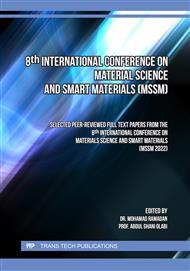p.3
p.11
p.19
p.25
p.35
p.45
p.55
p.65
Feasibility Study on Alternative Sensors for Acoustic Emission Damage Detection in Composite Structures
Abstract:
Polyvinylidene Fluoride (PVDF) and Lead Zirconate Titanate (PZT) thin-film sensors can be used to detect acoustic emissions, and their low thickness (28µm PVDF sensors available) allow them to be embedded (positioned within a laminate). However, the characteristics and sensitivity of these sensors within composite structures require further study. The attenuation curves of PZT, silver ink metallised PVDF and gold metallised PVDF sensors, when mounted using a variety of couplants such as ultrasonic gel, resin, silicone adhesive and thin double-sided adhesive tape, have been generated. Investigations also include positioning the sensor within the laminate, as opposed to on the surface, and monitoring the performance changes with respect to the through-thickness position. The sensors coupled using resin have shown to generally have the highest amplitude, with the highest being the PZT yielding 88 dB at 5cm. Initial comparisons of signal detection by the sensors with respect to fibre orientation have shown that signal travelling along the fibres generally has higher amplitude when compared to at 45o. This research is the first step toward identifying the preferred sensor type and position within the structure for damage detection.
Info:
Periodical:
Pages:
19-24
Citation:
Online since:
October 2023
Authors:
Keywords:
Price:
Сopyright:
© 2023 Trans Tech Publications Ltd. All Rights Reserved
Share:
Citation:



